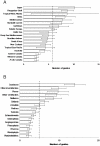A census of marine biodiversity knowledge, resources, and future challenges
- PMID: 20689850
- PMCID: PMC2914025
- DOI: 10.1371/journal.pone.0012110
A census of marine biodiversity knowledge, resources, and future challenges
Conflict of interest statement
Figures







References
-
- Bouchet P. The magnitude of marine biodiversity. Duarte CM, editor. The exploration of marine biodiversity: Scientific and technological challenges. 2006;33–64 Fundación BBVA, Madrid.
-
- Costello MJ, Wilson SP. Predicting the number of known and unknown species in European seas using rates of description. Global Ecology and Biogeography in press. 2010.
-
- Boero F. The study of species in the era of biodiversity: A tale of stupidity. Diversity. 2010;2:115–126.
-
- Eschemeyer WN, Fricke R, Fong JD, Polack D. Marine fish biodiversity: A history of knowledge and discovery (Pisces). Zootaxa. 2010;2525:19–50.
-
- Costello MJ, Emblow CS, Bouchet P, Legakis A. European marine biodiversity inventory and taxonomic resources: State of the art and gaps in knowledge. Marine Ecology Progress Series. 2006;316:257–268.
Publication types
MeSH terms
LinkOut - more resources
Full Text Sources
Other Literature Sources

